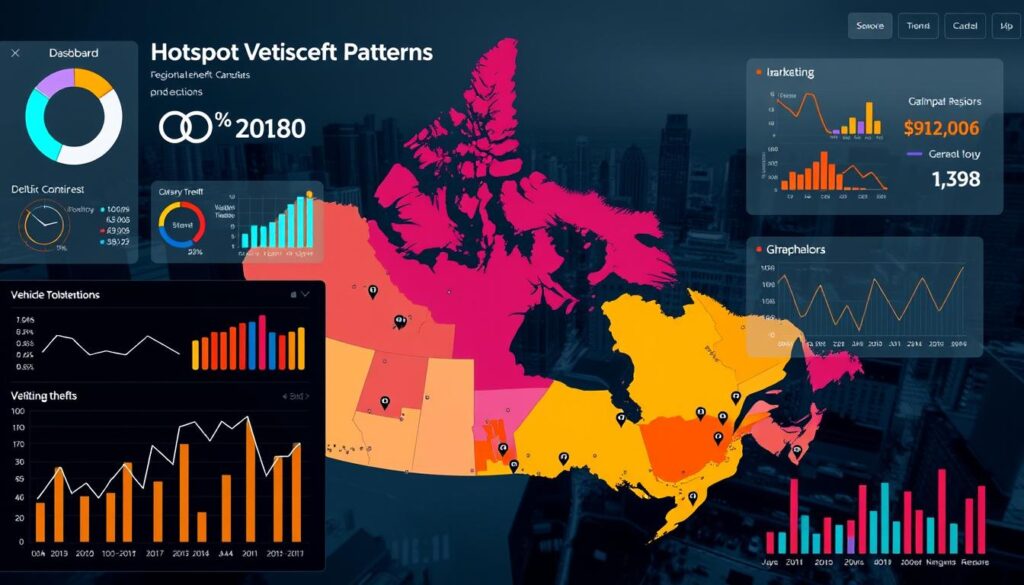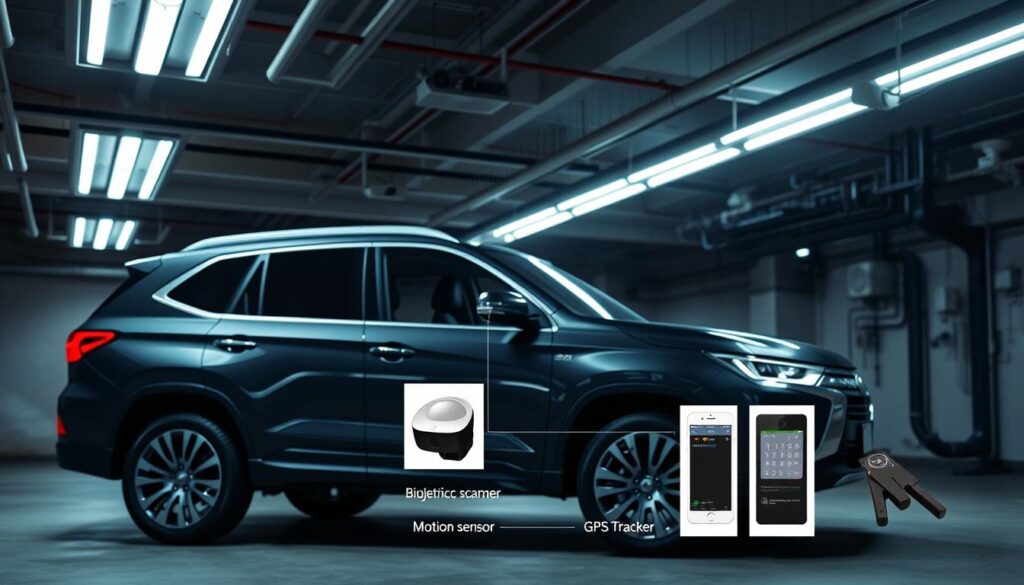Every 300 seconds, another motorist becomes a victim of auto theft in Canada. This shocking statistic reveals a crisis escalating faster than most realize, with provinces like Ontario and Quebec seeing nearly 50% jumps in theft rates since 2022.
What many don’t grasp is how these crimes fuel larger dangers. Stolen vehicles generate profits for organized crime networks, financing activities from drug trafficking to international terrorism. Your community’s safety depends on understanding this hidden connection.
Canada now faces global scrutiny as a key source for illegal vehicle exports. Sophisticated theft rings exploit modern technology and shipping systems, moving stolen goods across borders within hours. This isn’t petty crime – it’s transnational enterprise threatening national security.
The ripple effects touch every Canadian. Insurance premiums surge as claims multiply, while police resources strain under investigation demands. More critically, these crimes erode trust in community safety and damage Canada’s international standing.
Recognizing vehicle theft as a public safety priority – not just a property crime – marks the first step toward solutions. From encrypted key fobs to port security reforms, combating this crisis requires collective action at every level.
Overview of Auto Theft Trends in Canada
Canada’s auto theft crisis now operates at epidemic speed, with criminals targeting vehicles faster than authorities can track them. Recent data reveals patterns stretching beyond individual losses to systemic risks affecting national security.

Recent Statistics and Data Insights
In 2022, over 105,000 automobiles disappeared nationwide – one every five minutes. Toronto’s theft rate exploded by 48% year-over-year, while York Region saw nearly 3,300 vehicles vanish. These numbers don’t just represent missing property – they map criminal networks’ operational zones.
West Humber-Clairville became Canada’s theft capital during this surge. Regional disparities prove startling: some municipalities report theft increases exceeding 200% since 2019. Law enforcement agencies now deploy specialized units like York’s Operation Auto Guard to counter sophisticated theft rings.
Understanding the Impact on Public Safety
Your insurance costs rise directly from these crimes. More critically, stolen vehicles fund international drug operations and human trafficking. Each missing automobile potentially finances violence reaching your neighborhood.
Police resources strain under investigation demands, diverting attention from other community safety needs. This criminal ecosystem thrives on technological vulnerabilities in modern vehicles and lax port security – weaknesses criminals exploit within hours of theft.
Analyzing Top Stolen Cars in Canada
Certain vehicles dominate theft statistics not by accident but through calculated criminal strategy. Criminals prioritize models balancing high resale value with security weaknesses, creating a perfect storm for illegal exports and quick profits.

Model Popularity and Thief Preferences
The Honda CR-V tops theft lists for 2020, with over 5,600 units taken. Its parts fetch premium prices overseas, while its widespread ownership provides camouflage in shipping containers. Pickup trucks like the Dodge RAM 1500 and Ford F150 follow closely, prized for their durability in harsh climates abroad.
Luxury SUVs such as the Toyota Highlander and Lexus RX Series attract organized crime groups. These models disappear faster than police can track them, often reaching foreign ports within 48 hours. Thieves exploit their advanced tech features, which ironically create new vulnerabilities.
The Role of Electronic Security Flaws
Modern keyless entry systems have become a double-edged sword. Criminals use portable radio amplifiers to intercept fob signals from inside homes, unlocking vehicles without physical contact. This method accounts for 78% of thefts involving 2020-2023 models.
Manufacturers scramble to patch these flaws, but thieves adapt faster. Parking your vehicle in a Faraday cage or disabling wireless signals at night significantly reduces risks. Staying informed about your model’s security gaps could mean the difference between keeping your automobile and funding criminal networks.
Regional Hotspots and Theft Patterns
Vehicle theft patterns shift dramatically across Canada’s provinces, revealing how criminals adapt to local opportunities. Where you park matters as much as what you drive – urban centers and rural areas face distinct risks shaped by geography and criminal logistics.

Provincial Crime Landscapes
Ontario sees more stolen vehicles than any province, with 2,684 Honda CR-Vs disappearing in 2022 alone. The Land Rover Range Rover faces disproportionate risk here – one in 17 models gets targeted. Quebec mirrors this SUV focus but adds luxury marks like the Acura RDX, stolen every 7 hours on average.
Out west, Alberta’s truck culture attracts thieves. Older Dodge RAM 1500 models vanish 3x faster than newer versions due to weaker security. Even Atlantic Canada battles organized groups stealing Chevrolet/GMC Silverado trucks, despite lower population density.
City Streets vs Country Roads
Urban thieves prioritize luxury SUVs like the Range Rover for quick export. A Toronto-based Rover can reach Dubai within 72 hours. Rural criminals target work trucks – 43% of stolen RAM 1500s get dismantled locally for parts.
Your location changes the game. Cities face tech-savvy thieves using signal boosters, while rural areas deal with physical break-ins. Both scenarios feed the same criminal networks, proving no region remains untouched by this crisis.
Impact on Insurance and Financial Implications
The financial shockwaves of Canada’s auto theft epidemic reach further than most drivers realize. Every unrecovered vehicle triggers a chain reaction – from individual policyholders to national economic stability.
How Auto Theft Influences Insurance Premiums
Your auto insurance costs rise directly with theft rates. Models like the Honda CR-V see 18-25% higher premiums due to theft frequency. Insurers recoup losses by adjusting rates across entire regions, not just high-risk owners.
Comprehensive coverage becomes critical for protection. Without it, you risk losing thousands if your car disappears permanently. Even with protection, deductibles and depreciation leave gaps in financial recovery.
Financial Losses and Market Repercussions
The market absorbs $1.2 billion annually in theft-related losses. Legitimate buyers face inflated parts prices and reduced resale values. Organized crime’s demand for specific components warps local repair economies.
Groups like équité association partner with insurers to combat these trends. Their data shows recovery rates below 60% for luxury models, forcing insurance providers to increase reserves. These costs eventually trickle down to every policyholder’s premium.
Your choices matter. Selecting anti-theft devices or avoiding high-risk models helps stabilize rates industry-wide. Collective action could reverse this costly cycle.
Anti-Theft Solutions and Security Best Practices
Protecting your vehicle requires layered defenses that adapt to evolving criminal tactics. Modern security combines technology with smart habits to create multiple barriers against theft attempts. Start by addressing vulnerabilities criminals exploit most frequently.

Modern Security Technologies and Anti-Theft Devices
Upgrade your defenses with tools that make your automobile less appealing to thieves. GPS trackers help recover 63% of vehicles within 48 hours when installed properly. Steering wheel locks remain effective visual deterrents, reducing theft attempts by 41% according to RCMP data.
| Device Type | Effectiveness | Insurance Discount |
|---|---|---|
| Faraday Signal Blockers | Blocks 97% of key fob hacks | Up to 15% |
| Wheel Locks | Reduces theft risk by 40% | 5-10% |
| GPS Trackers | 90% recovery rate | 10-20% |
Practical Tips for Safeguarding Your Vehicle
Store key fobs in metal containers at night to block signal theft. Park in garages whenever possible – exposed vehicles face 3x higher theft rates. When street parking is unavoidable, turn wheels sharply toward curbs to complicate towing.
Always engage your emergency brake and remove valuables from sight. Criminals target automobiles with visible electronics or packages. Simple habits like locking doors and closing windows completely deter 58% of opportunistic thefts.
Choose well-lit areas with foot traffic for parking. Install motion-activated lights at home – darkness enables 74% of nighttime theft attempts. These strategies create multiple obstacles that discourage criminals from selecting your automobile.
Future Trends and Evolving Theft Tactics
The battle for vehicle security has become a high-stakes tech war. Criminals now use portable devices smaller than smartphones to bypass advanced protection systems. Your automobile’s safety depends on understanding these rapidly changing threats.

Predicted Developments in Car Security
Key fob cloning now accounts for 62% of thefts involving late-model vehicles. Thieves intercept wireless signals through walls, creating perfect replicas in seconds. Luxury models face unique risks – Lexus RX thieves exploit headlight wiring to hijack internal communication networks.
Manufacturers respond with biometric fingerprint scanners and quantum encryption for key codes. Future systems may use AI to detect suspicious behavior around parked automobiles. These upgrades aim to stay ahead of organized crime groups mastering electronic warfare.
How Innovation Is Changing the Landscape of Vehicle Protection
Multi-layered defense strategies now prove most effective. Pairing physical deterrents like steering locks with signal-blocking pouches reduces vulnerability by 89%. Real-time GPS tracking combined with automated theft alerts creates new recovery opportunities.
Your choices matter in this arms race. Upgrading security protocols and avoiding high-risk parking zones disrupt criminal workflows. As technology evolves, so must your approach to safeguarding personal transportation.
Conclusion
Canada’s fight against automotive crime demands more than individual action—it requires a united front. Popular models like the Ford F150 and Honda CR-V remain prime targets due to export demand and security gaps. These thefts ripple through communities, inflating insurance rates and fueling organized crime.
Your choices directly impact this cycle. Installing anti-theft devices disrupts criminal workflows, while understanding regional risks helps avoid high-theft zones. Data from équité association confirms vehicles like the Dodge Ram and GMC Silverado disappear fastest in specific provinces.
Proactive measures matter. Review your auto insurance coverage and consider GPS trackers for vulnerable models. Collaboration between drivers, insurers, and law enforcement builds stronger defenses against evolving theft tactics.
By staying informed and implementing layered protections, you help shrink markets for stolen vehicles. Every secured automobile weakens criminal networks—making roads safer and stabilizing costs for all Canadians.

